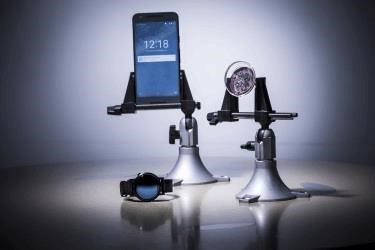"Interscatter" Tech Converts Bluetooth For WiFi-Connected Implants
By Jof Enriquez,
Follow me on Twitter @jofenriq

Engineers at the University of Washington (UW) have devised a new method of wireless communication that converts Bluetooth transmission from mobile devices into Wi-Fi signals. Using this "interscatter" communications technology allows medical devices and implants with limited power sources to gain the ability to send data using low-power Wi-Fi signals to smartphones and smartwatches.
The UW team previously described the technique of "backscattering" ambient RF signals — repurposing existing RF signals in the environment — to enable device-to-device communication without the need for onboard power sources. Now, the team builds on that prior research to introduce "interscattering," the inter-technology, over-the-air conversion of Bluetooth signals to create Wi-Fi transmissions.
The researchers wrote in a paper that novel medical devices, such as smart contact lenses and neural implants, currently have power constraints that limit their ability to generate Wi-Fi, Bluetooth, or ZigBee transmissions to communicate with smartphones, watches, and tablets. To overcome this, the researchers suggest an interscaterring communication system.
"We first transform a Bluetooth transmission into a single tone signal and use backscatter to create standards-compliant Wi-Fi packets on a single side of the resulting single tone Bluetooth signal," they wrote in the paper. But they first had to remove a mechanism designed to secure Bluetooth communication.
“Bluetooth devices randomize data transmissions using a process called scrambling,” said lead faculty Shyam Gollakota, assistant professor of computer science and engineering, in a press release. “We figured out a way to reverse engineer this scrambling process to send out a single tone signal from Bluetooth-enabled devices such as smartphones and watches using a software app.”
To test their technology, the researchers working at UW's Networks and Mobile Systems Lab and Sensor Systems Lab demonstrated three proof-of-concept applications: active contact lens systems that backscatter Bluetooth transmissions from a watch to generate Wi-Fi signals to a phone; an implantable neural recording device that communicates by using Bluetooth headsets and smartphones; and prototype "smart" credit cards that communicate with each other by backscattering Bluetooth transmissions from a smartphone.
“We allow a device like a smartwatch or smartphone to do the power expensive generation of radio signals, and then our low-power contact lens, implant or credit card reflects this signal in a way that encodes its own data,” said Vikram Iyer, a UW electrical engineering doctoral student who co-authored the paper, in an EE Times article. "The transmitter of such interscatter devices isn’t a normal radio. It’s just a switch connected to an antenna."
“Turning on and off this switch allows us to change how the antenna reflects energy. Just by turning on and off this switch at the right rate, our interscatter device is reflecting a Bluetooth signal created by something like a smartwatch to make it look like a Wi-Fi packet that can be received on your phone,” explained Iyer.
Power expended during the whole process is several orders of magnitude lower than current requirements, something the researchers claim to be very useful for future implants.
“Preserving battery life is very important in implanted medical devices, since replacing the battery in a pacemaker or brain stimulator requires surgery and puts patients at potential risk from those complications,” said co-author Joshua Smith, associate professor of electrical engineering and of computer science and engineering, in New Atlas. “Interscatter can enable Wi-Fi for these implanted devices while consuming only tens of microwatts of power.”
“Interscattering” radio waves all around us have implications in day-to-day life, including the way we communicate, buy things, and manage chronic conditions.
"Providing the ability for these everyday objects like credit cards – in addition to implanted devices – to communicate with mobile devices can unleash the power of ubiquitous connectivity," said Gollakota.
